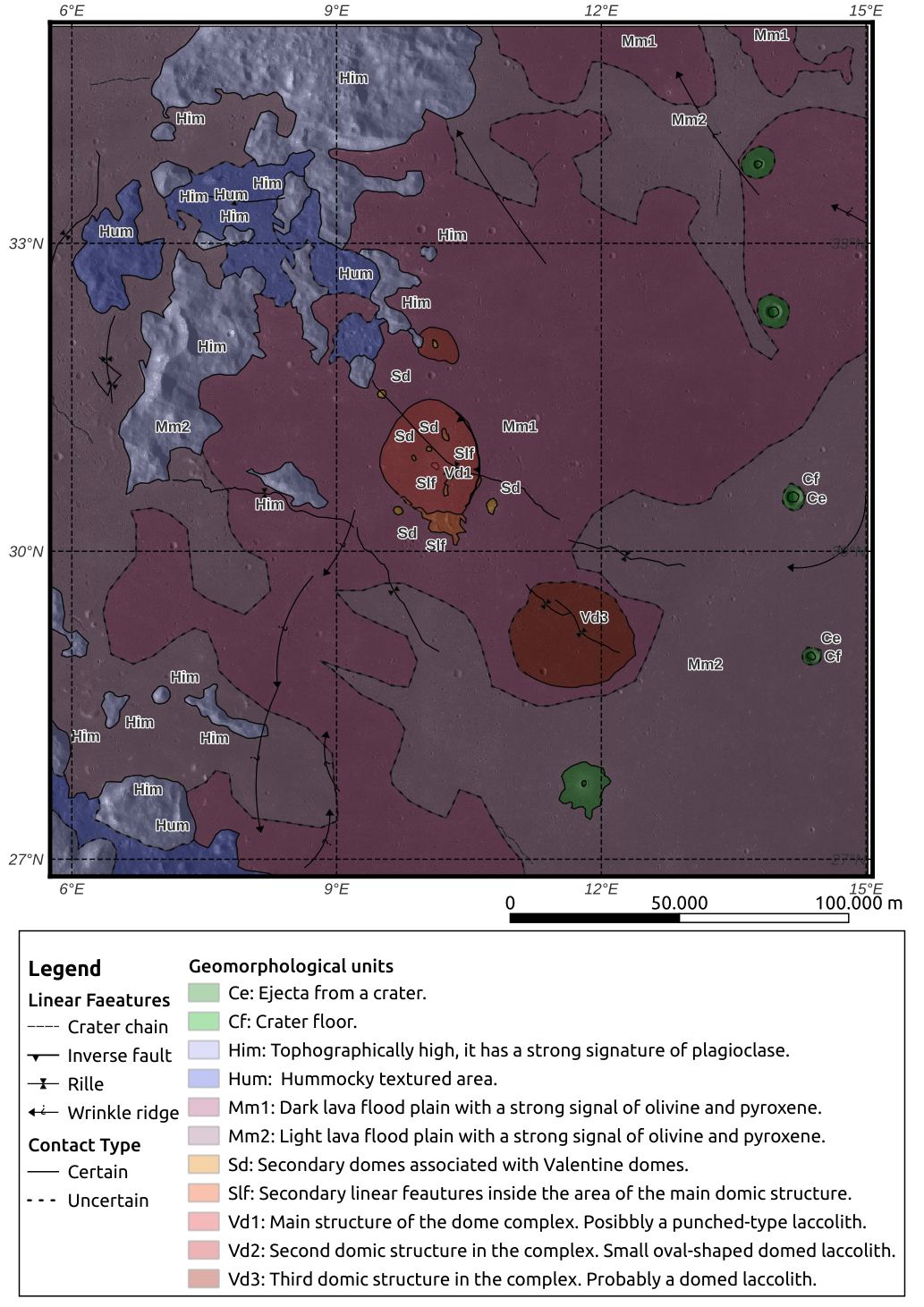Geomorphologic mapping of the Valentine Domes in the Moon, intrusive domes, and their mineral resource potential
- Jacobs University, Physics & Earth Sciences, Germany
Introduction
Lunar robotic and human exploration efforts are ramping up, as exemplified by ongoing studies and missions from different space agencies, such as NASA and ESA with the Artemis program (e.g. NASA, 2020). In this scenario, the identification of potential resource deposits is of primary importance for the future exploration of planetary bodies (e.g. Lewis et al., 1993; van der Bogert et al., 2021). One of the most important deposits on Earth, but not well studied outside our planet, are the intrusive igneous processes and their derivative features. This work is the first step in ongoing research to evaluate the potential of this kind of geological setting on the Moon. We conducted a detailed analysis of an intrusive complex named Valentine Domes.
The Valentien Domes are located at the west margin of the Serenitatis Basin (30.69° N, 10.20° E). According to Wöhler and Lena (2009), they consist of two different edifices, a small one to the north and a big asymmetric dome 70 km wide to the south. The same authors identified a large fault at the east side of the bigger edifice, indicating that it originated as a laccolith (Schmiedel et al., 2017).
Data
In order to conduct the geomorphological and tectonic interpretation of the zone, we collected and processed 23 images taken by the Narrow-Angle Camera (NAC) onboard the Lunar Reconnaissance Orbiter (LRO). A high-resolution stereo-derived DEM was also generated using the Ames Stereo Pipeline (ASP)(Beyer et al., 2022). We also used some basemaps of the Moon, such as a global visible mosaic made with takes from the Wide Angle Camera (WAC), and a digital elevation model (DEM) derived from the Kaguya mission.
We coupled the prior analysis with mineralogical information derived from two hyperspectral cubes taken by the Moon Mineralogy Mapper (M3), onboard Chandrayann-1.
Results
Figure 1 shows the geomorphological map of the zone.
The area is dominated by lava flood plains that show variations in their albedo. Darker lavas accumulated close to the rim of the basin, while in the centre of the Serenitatis and Imbrium basins the lavas have a lighter tone. The two domic features identified by Wöhler and Lena (2009) lie close to the rim of the basin, but we identified what looks to be a third dome to the south of the principal structure. This newly identified dome has a maximum altitude of 90 meters and it steeps gently to the surroundings. No faulting is visible near the dome, which leads us to classify it as a domed laccolith (Schmiedel et al., 2017).
The uplands located on the rim of the Serenitatis Basin can be divided into Hilly materials (Him) and more dissected Hummocky materials (Hum). These materials at a first glance appear similar to a handful of small mounds located inside and around the Valentine Domes, this led Lena et al. (2018) to describe these features as kipukas from the floor of the basin. From the analysis using data from M3, we found that there is an apparent difference in composition between these mounds and the Him and Hum units. The units of the rim seem to have a major amount of plagioclase, which could point to a genetic difference between them and the mounds inside de domes. Thus, we mapped these features as different units: Secondary domes (Sd) and Secondary linear features (Slf).
We identified linear rilles crossing the main structure dome and the newly discovered dome. These lineations cross both domes almost by their centre, and in the case of the main dome, the rile is weakly aligned with the secondary domes inside it.

Figure 1: Geomorphological map of the Valentine Domes and northwest Serenitatis Basin.
Discussion and conclusions
The discovery of a new dome south of the principal structure could imply that the Valentine Domes complex is more intricate than previously thought. This is supported by the presence of linear riles crossing the domes, which according to Head and Wilson (1992), points to the existence of stagnated dykes not far beneath the surface. The secondary domes and the thrust fault cutting the main structure are hints that plutonic rocks could be located on the surface, alongside useful mineralizations.
Acknowledgments
This project has received funding from the European Union’s Horizon 2020 research and innovation program under grant agreement No 101004214.
How to cite: Suarez Valencia, J. E. and Pio Rossi, A.: Geomorphologic mapping of the Valentine Domes in the Moon, intrusive domes, and their mineral resource potential, Europlanet Science Congress 2022, Granada, Spain, 18–23 Sep 2022, EPSC2022-923, https://doi.org/10.5194/epsc2022-923, 2022.

